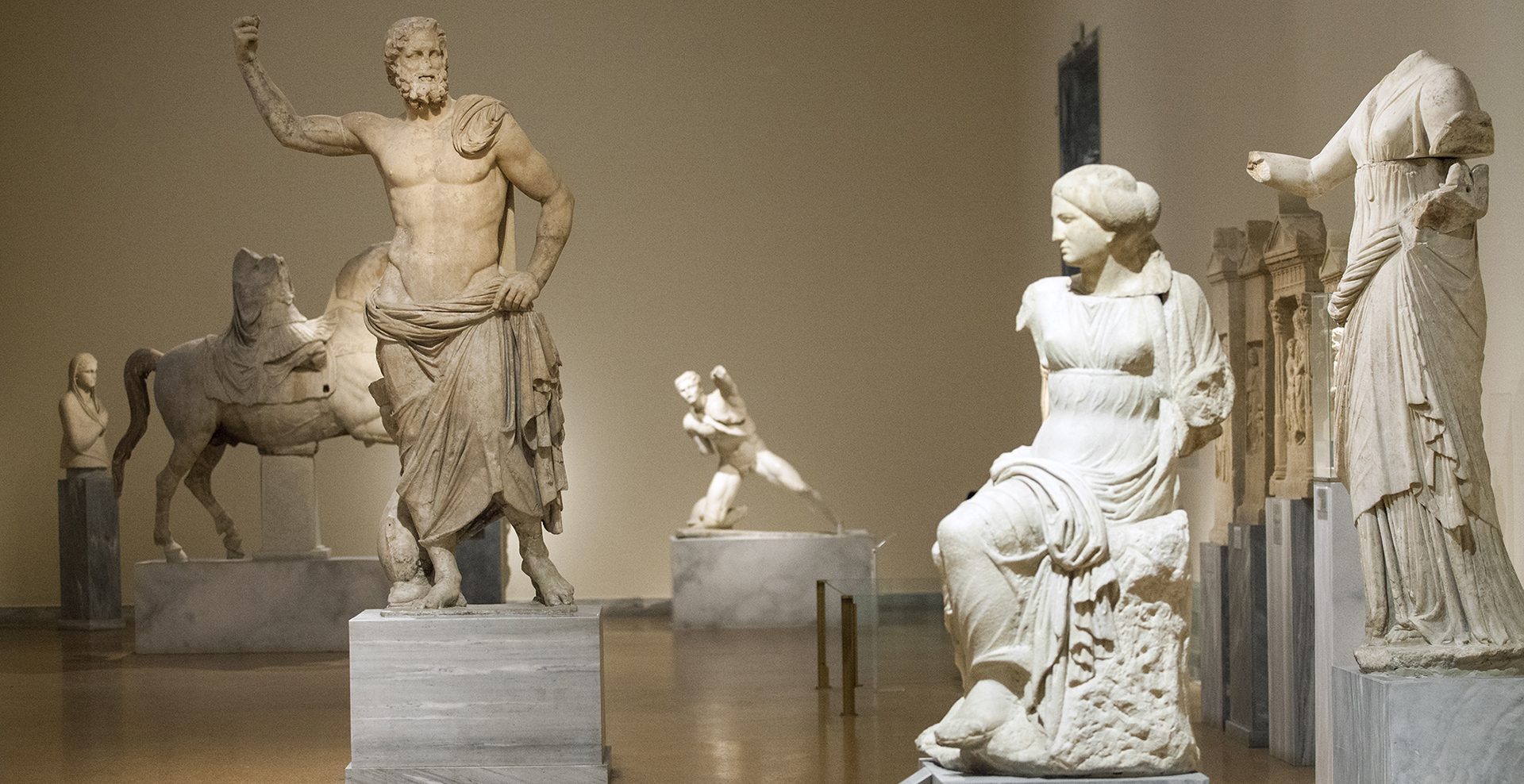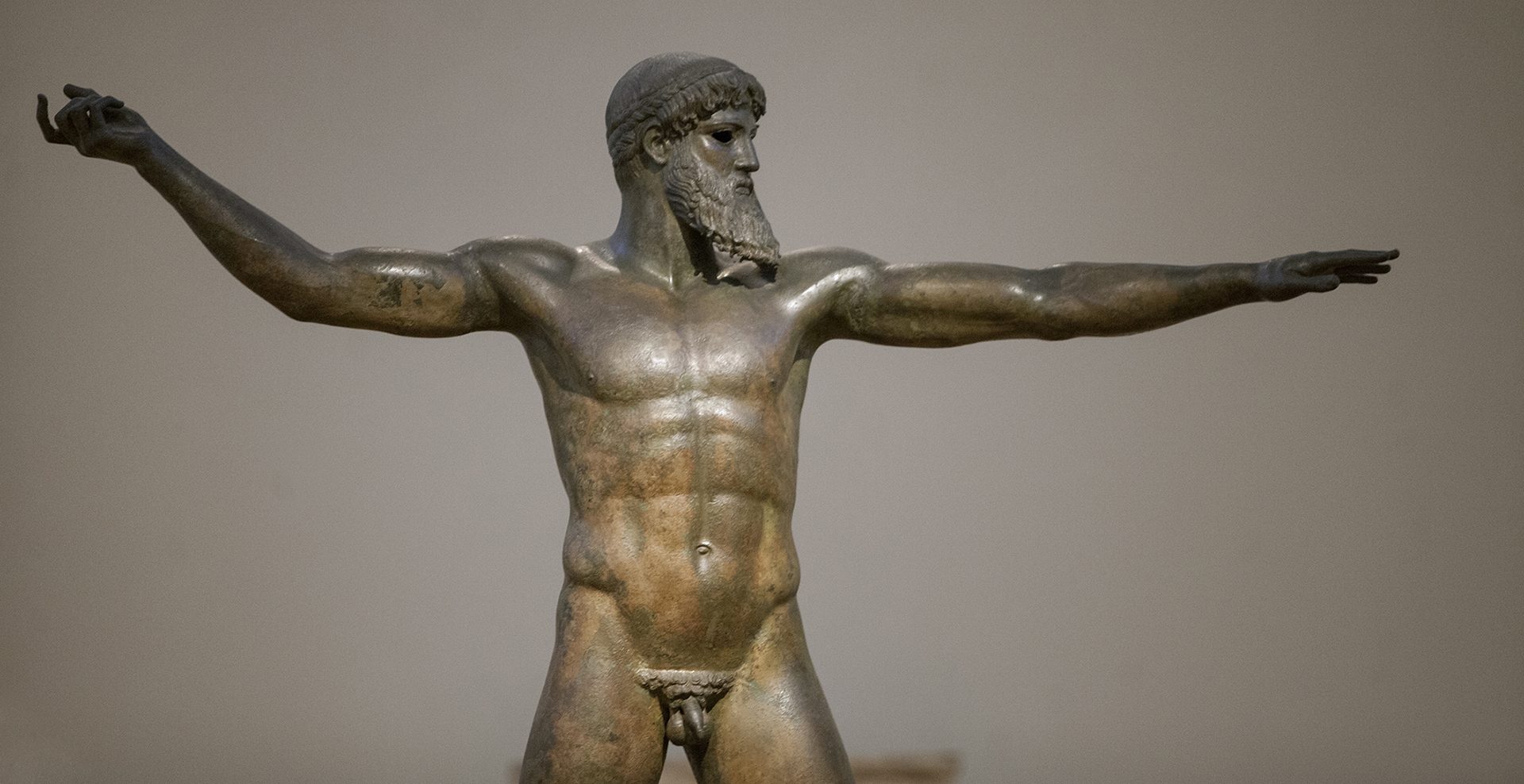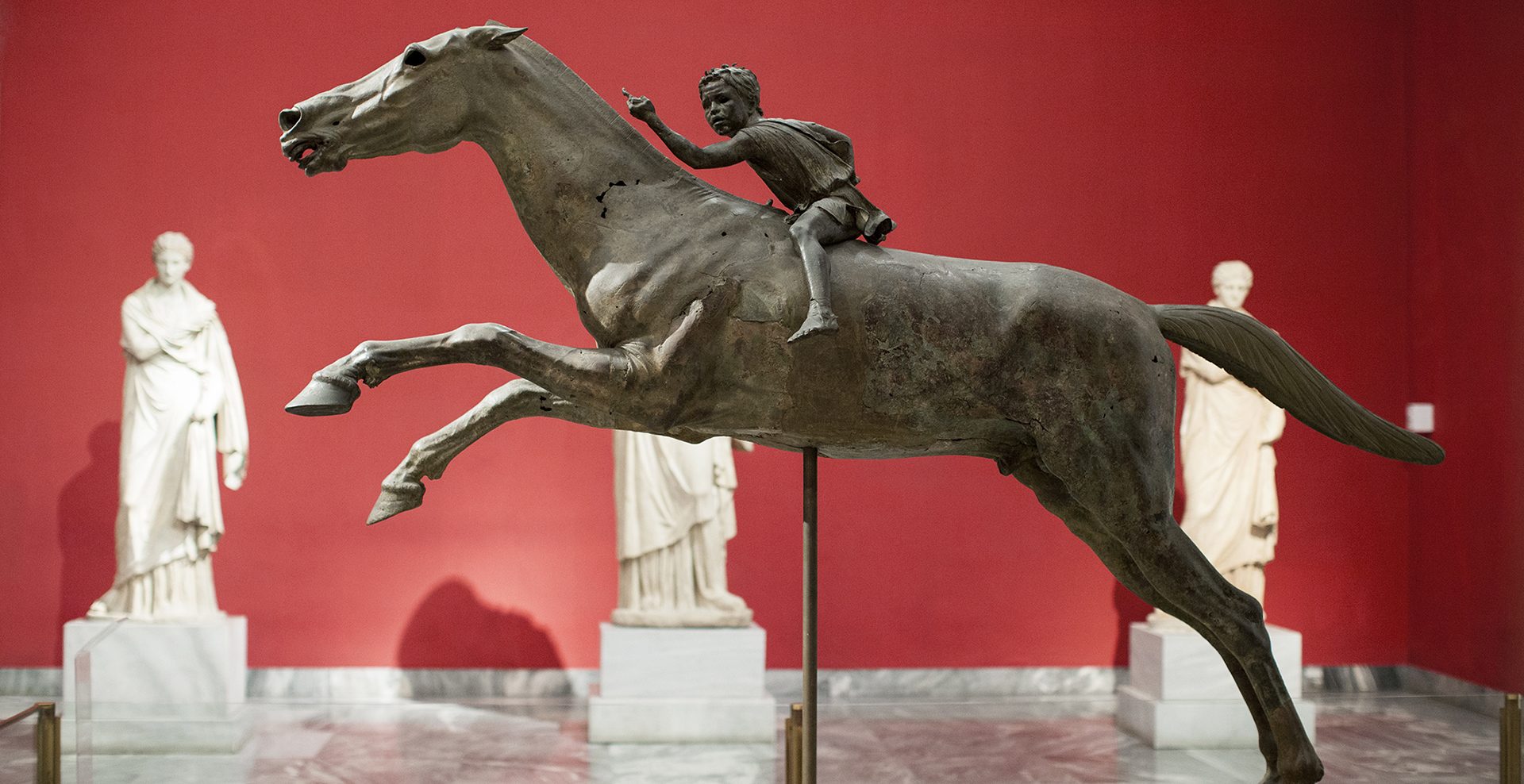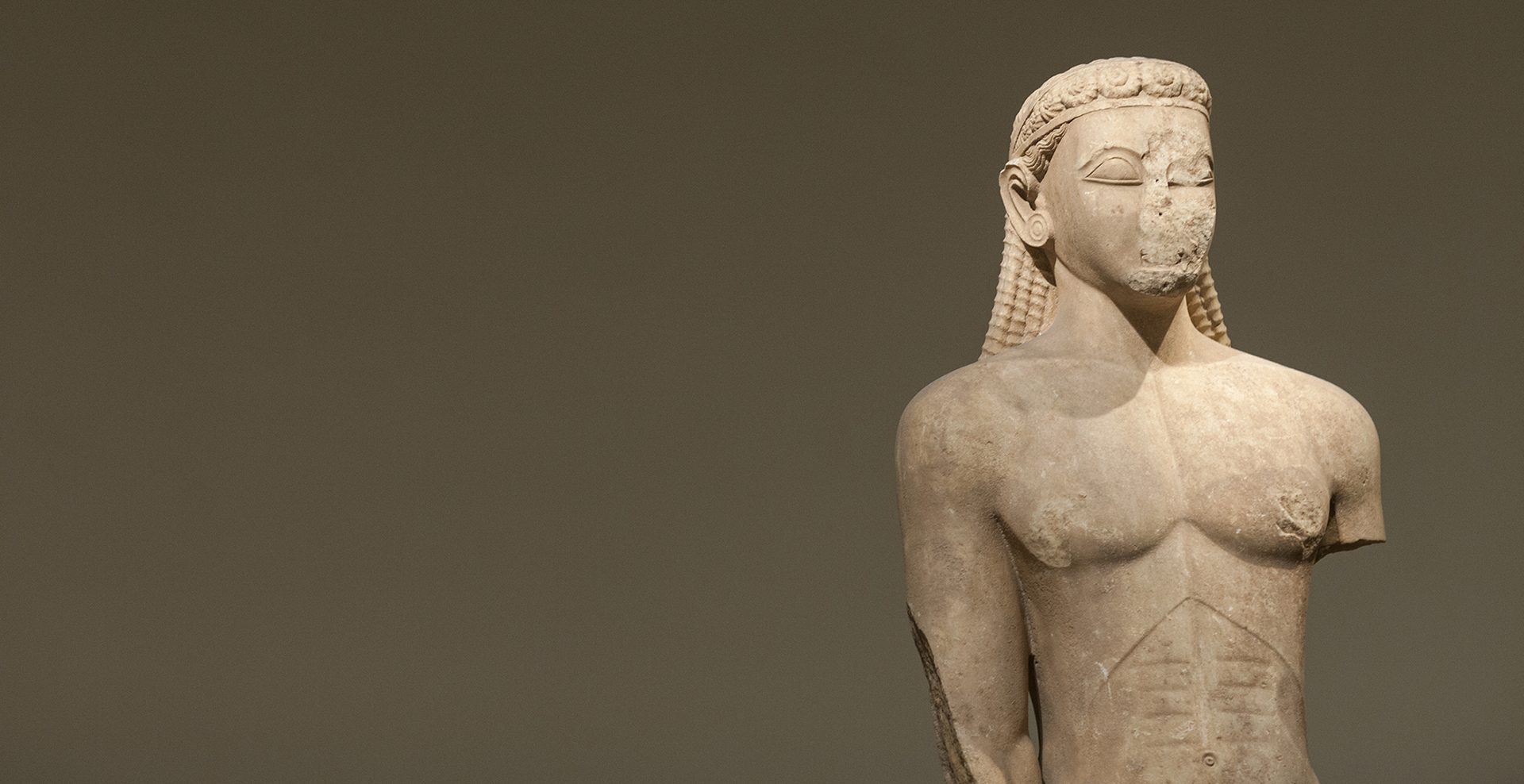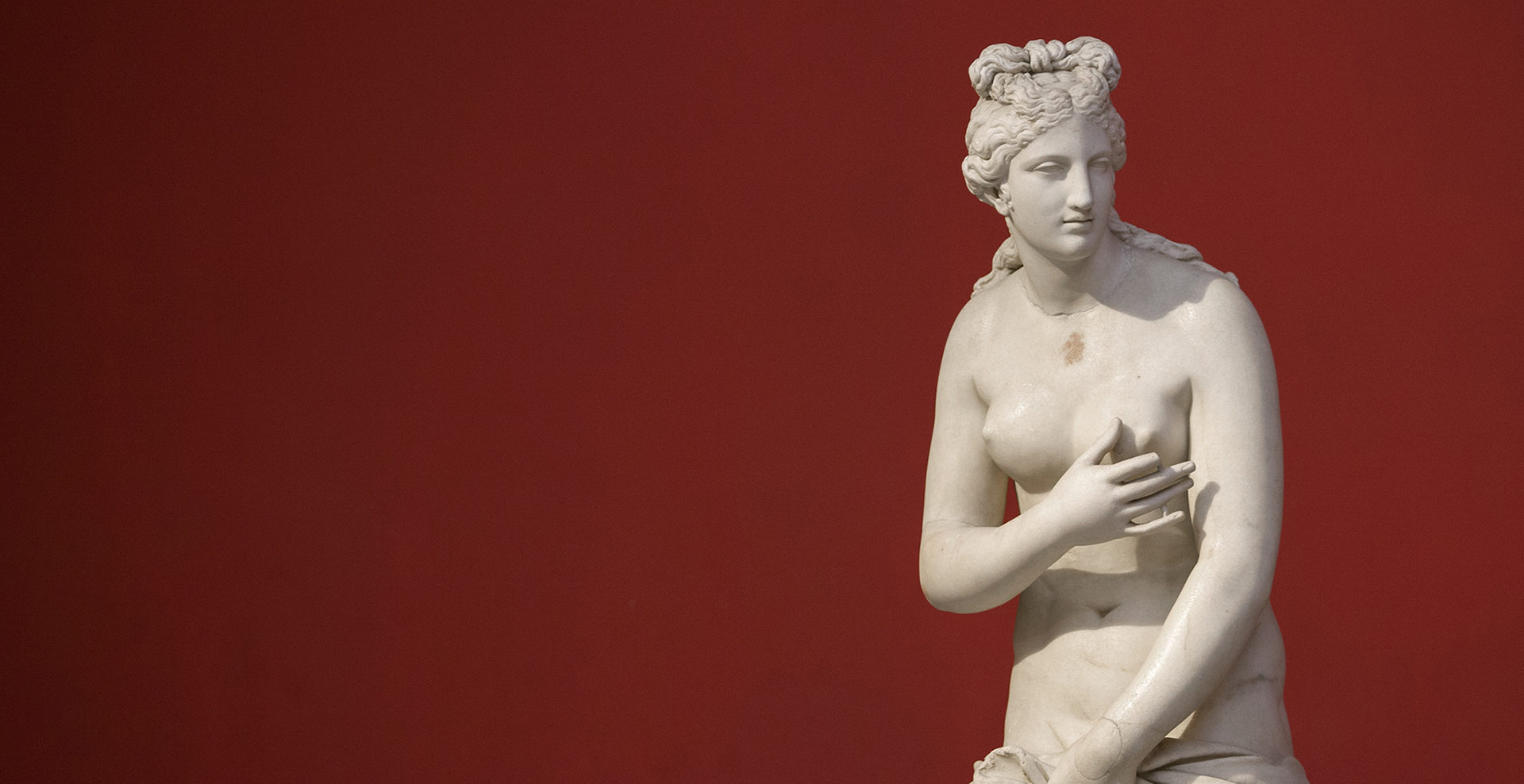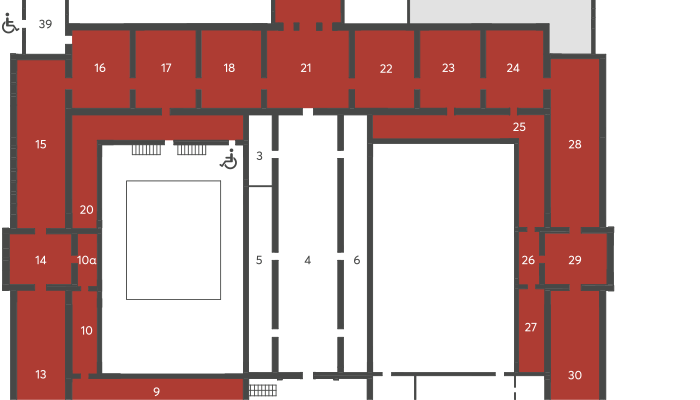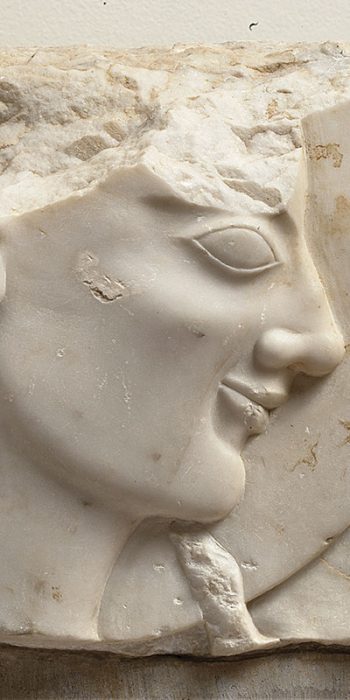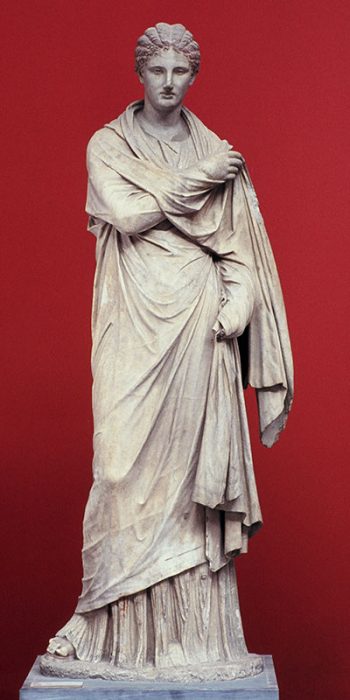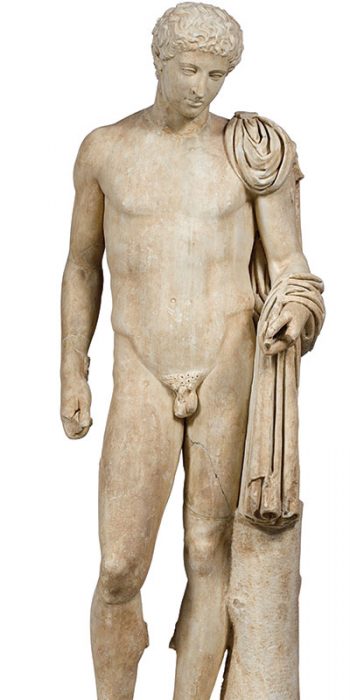Sculpture Collection
The History of the Collection
The National Archaeological Museum houses the largest and one of the most significant collections of sculpture of Greek antiquity worldwide, dating from the 7th century BC to the 5th century AD. The formation of the collection was initiated in 1829 with the foundation of the museum on Aegina, whereas later it included marble and stone sculptures from the public archaeological collections of Athens, from excavations and acquisitions of the Archaeological Society at Athens as well as from other regions of the Greek world. The Collection comprises approximately 17.000 works, of which 1.000 are on display in Rooms 7-34 on the ground floor of the building, in the atrium and the Room of the Cypriot Collection, in Room 64 on the upper floor, whereas those sculptures in storage are accessible to researchers. Individual sculptures are also exhibited in the Egyptian Collection, the Vase Collection and the Stathatos Collection.
Browse the exhibition
The dawn of sculpture in the historical period: 8th-5th century BC (Rooms 7-14)
By the 8th century BC the Greek populations had completed their migration and established city-states, adopted the common name Greek, the alphabet, the Greek myths and the Dodekatheon (Twelve Olympian Gods) and also a method of calculating time based on the first Olympic Games (776 BC).
From the 7th century BC onwards the old temples that were made of timber were gradually replaced by stone-built structures adorned with architectural sculptures, such as the reliefs from the temple of Athena at Mycenae (no 2869, Room 7). Over the same time period, the earlier wooden statues (which were in effect plank-shaped images, called xoana) were also substituted by their stone counterparts, which nonetheless, preserved the traditionally stiff and austere shape, such as the statue of Artemis dedicated by Nikandre of Naxos (“Dedication of Nikandre”) to the temple of Apollo on Delos (no 1, Room 7). The same rigid pose is encountered on smaller sculptures depicting the human figure, such as those made of ivory (no 776, Room 7) and also on the funerary (grave) monuments, such as the monument of the brothers Dermys and Kit(t)ylos, portrayed embracing each other tightly, that had been installed over their grave at Tanagra in Boeotia by their father Amphalkes (no 56, Room 8). Similarly stiff is the pose of the female figures that mourn a deceased woman over her bier illustrated on the large clay amphora that also served as grave marker (sema) at the cemetery of the Kerameikos in a different rendering of the dead body of an eminent person (no A804, Room 7).
Marble statues were dedicated to the temples or mounted over the graves of significant people as grave markers (semata). These statues, the Kouroi or Korai (youths and maidens), created in the 6th century BC, are frontally depicted with restricted movement, yet they all smile at us. The Kouroi are portrayed standing with their arms extending downwards at the side of their torso, with their left foot slightly advanced. They are usually nude, while emphasis is placed on the modelling of the muscles; however some of them are shown wearing painted sandals, as in the case of the large Sounion Kouros that had been dedicated to the sanctuary of Poseidon there (no 2720, Room 8). Several examples of Kouroi follow in the next Rooms; among the most important are the Kouroi of the Kerameikos (no 3372, Room 11), of Myrhinnous (Attic deme, present-day Merenda) (no 4890, Room 11), of Volomandra (no 1906, Room 11) and the Anavyssos Kouros in Attica (depicting Kroisos who died in battle, no 3851, Room 13), of the sanctuary of Apollo at the Boeotian mountain Ptoon (no 20, Room 13), and also the latest Kouros of the Collection, Aristodikos, from Mesogeia (no 3938, Room 13). The sole Kouros that is depicted clothed was found on the riverbed of the Athenian river Ilissos (no 3687, Room 13). Bases of Kouroi decorated with relief representations of sports and games were possibly installed over the graves of athletes (no 3476, 3747, Room 13). The Korai are shown standing lifting their garment with one hand, whereas the other hand carries either a flower bud or a fruit before their chest. The earliest and best preserved Kore of the Collection is Phrasikleia that was unearthed together with the Kouros of Myrrhinous and is portrayed wearing jewels and red peplos (no 4889, Room 11), whereas two Korai from the Acropolis of Athens (BE 15, 16, Room 13) follow, as well as the Kore of Eleusis (no 26, Room 14). The sculptural funerary monuments of the time could also take the form of very tall stelae (up to 4,5 m in height) (no 2687, Room 11) crowned with the statue of a sphinx, a mythological creature with the head of a woman and the body of a winged lion (Room 11). In the transitional phase to the Classical Period bronze statues were also cast, such as Poseidon that was recovered from the seabed off the south coast of Boeotia. The statue that had been dedicated to the god, according to the inscription found at the base, shows him holding his trident vertically (no X11761, Room 14). In the temples of the time the pediments (the triangular part at the top of the front of a building beneath the roof) are decorated with multi-figure battle scenes, as in the case of the temple of Athena Aphaia on Aegina (Room 14).
The sculpture of the Classical Period – 5th and 4th century BC (Rooms 15-28 and 34)
In the 5th century BC democracy was already established in Athens (in 508 BC by Cleisthenes) and the Greeks confronted the invasion of the Persians, the greatest military power of its day. The victories at the battles of Marathon and Plataea and also the naval battle of Salamis brought about an era of intellectual creativity, material prosperity and democratic consolidation under the leadership of Pericles. Athens became the centre in which sculptors, among other artists, arrived from other regions, thereby contributing to the embellishment of the buildings and monuments of the city with works of high quality and originality.
At the outset of this period sculpture conquers the third dimension. One of the rarest bronze works preserved is the statue of Zeus or Poseidon that was retrieved from the seabed off Cape Artemision on Euboea and depicted either Zeus holding the thunderbolt or Poseidon carrying his trident (no X15161, Room 15).
At the peak of the 5th century BC, the great sculptors drew their inspiration from the human body imparting ideal (idealized) beauty and spiritual meaning. The large relief that shows the three main figures of the mystery cult in the Eleusinian sanctuary: Demeter, Persephone and the young hero Triptolemus (no 126, Room 15) was found at Eleusis. Next to the relief lies the clay “Ninnion Tablet” that was dedicated to the same sanctuary by a faithful woman named (the) Ninnion (no A11036, Room 15). Of the statue of Nemesis, attributed to the sculptor Agoracritus, that was venerated at Rhamnous, a Roman copy is preserved (no 3949, Room 19). A work of his master, the Athenian Pheidias, was the chryselephantine statue of Athena Parthenos (made of ivory and gold) on the Acropolis of Athens. Of the huge work that was 12 metres tall, a small Roman version is preserved, rendered in marble (no 129, Room 20). The marble statue of “”Diadoumenos”” from Delos depicting an athlete who binds the ribbon of victory around his forehead that was once gilded is a Late Hellenistic copy of the original bronze work by Polykleitos from Argos (no 1826, Room 21).
Harsh times followed associated with the Peloponnesian War (431-404 BC), the civil strife between Athens and Sparta. The erection of funerary monuments that had been banned in the past by law for political and economic reasons was allowed once again for the victims of the war and the plague (epidemic) that broke out at the early stages of the conflict. Large marble vases that entailed special symbolism are frequently encountered (Room 16), or simple stelae, such as the one that depicts a youth holding the bird which he has just released from its cage, perhaps in a symbolic gesture that signifies the emancipation of the soul from his dead body (no 715, Room 16). Sometimes, they take the form of a naiskos (small temple) inside of which the deceased is depicted, such as the stele of Hegeso from the Kerameikos who is portrayed seated before her saddened slave (no 738, Room 18).
The end of the war signalled the Spartan leadership, but soon Athens and Thebes regained their strength, until the Panhellenic hegemony was successfully claimed by the Macedonian kings Philipp II and Alexander the Great. Large Greek urban centres developed, whereas in sculpture local schools represented by eminent sculptors had been created already before the end of the war. Sculpture is inspired by the rich movement of drapery that follows the movement of the body, as in the case of the female figures of the Peloponnesian sculptor Timotheus intended for the temple of Asclepius at Epidaurus (Room 22). Skopas from Paros undertook the building of the temple of Athena Alea at Tegea in Arcadia (Room 28). Praxiteles, son of the Athenian sculptor Cephisodotus, created nude, sensual works, while the bronze ephebe (youth) that was retrieved from the sea off Marathon (no X15118, Room 28) has been attributed to his school. The bronze ephebe that was recovered from the sea off Antikythera (no X13396), Room 28) adheres to the tradition established by Polykleitos. Lysippos had created the statue of Hercules leaning against his club, a copy of which is the oversized figure of Hercules discovered in the shipwreck of Antikythera and is now on display at the atrium. We are startled by its dark surface, as a result of the pollutants and the corrosion caused by the seawater, making it hard to imagine that it was actually made of bright Parian marble.
During the Classical period a wide range of reliefs were created that also incorporated texts of the decrees issued by the city of Athens (Room 25) or took the form of a cave (Room 25) or human body parts (Room 26, display case).
Hellenistic sculpture: Late 4th – early 1st century BC (Rooms 29-30 and 34)
The period dominated by the Diadochi (Successors) to Alexander the Great and their kingdoms that stretched across Greece, Asia and Egypt is called Hellenistic. New major urban centres emerged, such as Pergamon, Antioch and Alexandria. The citizens of these kingdoms experienced a cosmopolitan character that was further enhanced by the widespread use of a common language the Hellenistic Koine, a simplified form of the Attic dialect. The ethical conduct of the citizens was influenced by new philosophical movements, whereas the religious quests led to the consolidation of mystery cults that called for initiation in order for the faithful to achieve now personal salvation.
In sculpture, new local workshops and renowned sculptors that rendered the figures realistically, depicting their personal features, came to the fore. At Lykosura in Arcadia, Damophon from Messene created a composition 6 metres tall (including the pedestal): Demeter and Despoina are venerated seated on a common throne flanked by Artemis and Anytus, one of the Titans, (Room 29). At Aigeira in Achaea the Athenian Eukleides created the colossal statue of Zeus enthroned, known to us from its depiction on coins, but unfortunately, only the head and one arm are preserved (nos 3377 and 3481, Room 30). The group of Aphrodite and Pan, possibly dedicated by a man named Dionysios from Beirut, was unearthed on Delos: the smiling goddess, assisted by the flying Eros brandishes her sandal against the erotically disposed goat-footed Pan who assaults her (no 3335, Room 30). The bronze race horse with its young rider (“”The Artemision Jockey””) was lifted from the sea off Cape Artemision on Euboea (no X15177, Room 34).
Roman sculpture: 1st century BC – 5th century AD (Rooms 31-33)
From the 2nd century BC onwards Greece was gradually conquered by the Romans until their eventual dominance in 31 BC and the fall of the Ptolemaic Kingdom.
The building programme designed for the capital of the Roman Empire had a twofold impact: initially the Greek cities were stripped of their artistic treasures that were transferred as spoils to Rome and concurrently some artists moved to the city. Subsequently, new local workshops were established in order to satisfy the demand for copies of Classical and Hellenistic works. Later, in the 2nd century AD, Athens turned once again into an artistic centre, mainly as a result of the special favour which the Philhellene emperors Hadrian and Antoninus Pius had shown. The Neo-Attic production thus emerged featuring mainly decorative reliefs (marble panels suspended on the wall) (no 5147, Room 31), marble sarcophagi (no 1186, Room 32) and trapezophora (marble table supports) (no 2706, Room 33).
The Roman administration was promoted through art and particularly sculpture, with the creation of portraits of the emperor, members of his family and also dignitaries or scholars, as these are successively displayed, grouped by dynasty. The bronze equestrian statue of Octavian Augustus recovered from the sea between Euboea and Hagios Eustratios (no X23332, Room 31) and the portrait of Hadrian’s companion Antinous, the beautiful youth who drowned in the Nile (no 417, Room 32) are markedly distinguished
Cypriot Collection (Room 64)
The Cypriot Collection was formed of donations and confiscations and consists, among others, of 160 sculptures made of local Cypriot stone. The head of a bearded young male with hair that imitates that of the Ionian Kouroi (no 1832) and the head of a goddess wearing kalathos headdress and lavish jewels (no 66) are among the most notable exhibits.
Dr Despina Ignatiadou, archaeologist
Head Curator of the Sculpture Collection
National Archaeological Museum
Archaeological Terms
Statue: life-size figure of a person or animal made of stone, metal or other material
Statuette: figure of a person or animal, smaller than life size, made of stone, metal or other material
Relief: sculpture on which forms and figures stand out from the flat surface of a plaque
Votive: work dedicated to a temple or sanctuary
Architectural sculpture / relief: sculptural work that formed part of the decoration of a building
Architectural members: part of a building made of stone
Altar: structure on which sacrifices are offered
Funerary monument / statue / relief / stele: grave monument, marker of a grave
Historical times: the period of human history documented by written records
Kouros and Kore: statue of a nude young male figure standing or a draped young female figure standing, encountered in the 6th century
Plastic = sculpture
Bust: sculpture of the head and chest of a figure Portrait: head carved in the round that renders realistically the features of the depicted person
Sarcophagus: stone coffin
Stele: tall, oblong plaque


